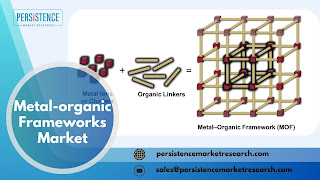- Get link
- X
- Other Apps
- Get link
- X
- Other Apps
Market Overview: Exploring Growth Trajectories and Market Dynamics
The Metal-Organic Frameworks (MOFs) market is experiencing robust growth trajectories driven by diverse factors and dynamic market dynamics. The increasing demand for advanced materials across various industries is a primary driver, fueling the expansion of MOFs applications. As research and development continue to push boundaries, MOFs are gaining traction for their unique properties and versatile applications.
Metal-organic Frameworks (MOFs) are porous materials consisting of metal ions or clusters coordinated to organic ligands. They form highly ordered structures with exceptional porosity and surface area, making them attractive for applications such as gas storage, separation, catalysis, and drug delivery. The global metal-organic frameworks market is forecast to expand at a CAGR of 13.2% and thereby increase from a value of US$8.1 Bn in 2023, to US$24.3 Bn by the end of 2030. The increasing demand for sustainable materials, coupled with advancements in synthesis techniques, is driving market expansion.
Metal-Organic Frameworks (MOFs) represent a rapidly growing segment in the materials market, characterized by their unique structure and versatile applications across various industries. MOFs are crystalline materials composed of metal ions or clusters connected by organic linkers, forming highly porous structures with large surface areas. This distinctive architecture enables MOFs to exhibit exceptional properties that make them attractive for a wide range of applications.
The Metal-Organic Frameworks market has witnessed significant growth in recent years, driven by several key factors:
Versatile Applications: MOFs find applications in diverse fields such as gas storage and separation, drug delivery, catalysis, sensing, and environmental remediation. Their tunable properties and high surface areas make them suitable for addressing a multitude of challenges across different industries.
Gas Storage and Separation: One of the primary applications of MOFs is in gas storage and separation. These materials exhibit high gas adsorption capacities, making them ideal candidates for storing gases such as hydrogen, methane, and carbon dioxide. MOFs also show promise in carbon capture and storage applications, contributing to efforts aimed at mitigating climate change and reducing greenhouse gas emissions.
Drug Delivery Systems: MOFs have garnered significant interest in the pharmaceutical industry for their potential applications in drug delivery systems. The porous structure of MOFs allows for the encapsulation and controlled release of drugs, improving their therapeutic efficacy and reducing side effects. Researchers are exploring the use of MOFs to deliver a wide range of pharmaceutical compounds, including anticancer drugs, antibiotics, and anti-inflammatory agents.
Catalysis and Green Chemistry: MOFs serve as effective catalysts for various chemical reactions due to their high surface areas and tailored functionalities. These materials can be designed to exhibit specific catalytic properties, making them valuable for promoting green chemistry practices and sustainable manufacturing processes. MOF-based catalysts are being utilized in reactions such as hydrogenation, oxidation, and photocatalysis, offering enhanced activity and selectivity compared to traditional catalysts.
Sensing and Detection Technologies: MOFs are also finding applications in sensing and detection technologies, thanks to their ability to selectively adsorb target molecules. MOF-based sensors exhibit high sensitivity and selectivity, making them well-suited for detecting gases, chemicals, and biomolecules in various environments. These sensors have applications in environmental monitoring, healthcare diagnostics, food safety, and security.
Despite the promising opportunities presented by MOFs, several challenges remain to be addressed to realize their full potential:
Synthesis and Scalability: The synthesis of MOFs can be complex and time-consuming, requiring precise control over reaction conditions and the selection of suitable building blocks. Scalability is also a concern, as large-scale production methods for MOFs are still under development.
Stability and Durability: Some MOFs may suffer from stability issues under certain conditions, such as exposure to moisture or high temperatures. Improving the stability and durability of MOFs is essential for their practical applications in real-world environments.
Cost Considerations: The cost of producing MOFs, particularly those based on rare or expensive metal ions, can be prohibitive for commercialization. Developing cost-effective synthesis routes and using abundant and inexpensive raw materials are crucial for making MOFs more economically viable.
In conclusion, the Metal-Organic Frameworks market is poised for continued growth and innovation as researchers and industry stakeholders address the technical challenges and explore new applications for these remarkable materials. With ongoing advancements in synthesis techniques, characterization methods, and industrial-scale production processes, MOFs are expected to play an increasingly significant role in addressing global challenges related to energy, healthcare, and environmental sustainability.
Explore the Latest Trending “Exclusive Article” @
About Persistence Market Research:
Business intelligence is the foundation of every business model employed by Persistence Market Research. Multi-dimensional sources are being put to work, which include big data, customer experience analytics, and real-time data collection. Thus, working on “micros” by Persistence Market Research helps companies overcome their “macro” business challenges.
Persistence Market Research is always way ahead of its time. In other words, it tables market solutions by stepping into the companies’/clients’ shoes much before they themselves have a sneak pick into the market. The pro-active approach followed by experts at Persistence Market Research helps companies/clients lay their hands on techno-commercial insights beforehand, so that the subsequent course of action could be simplified on their part.
Contact Us:
Persistence Market Research
Teerth Technospace, Unit B-704
Survey Number - 103, Baner
Mumbai Bangalore Highway
Pune 411045, India
Email: sales@persistencemarketresearch.com
Web: https://www.persistencemarketresearch.com
- Get link
- X
- Other Apps

Comments
Post a Comment